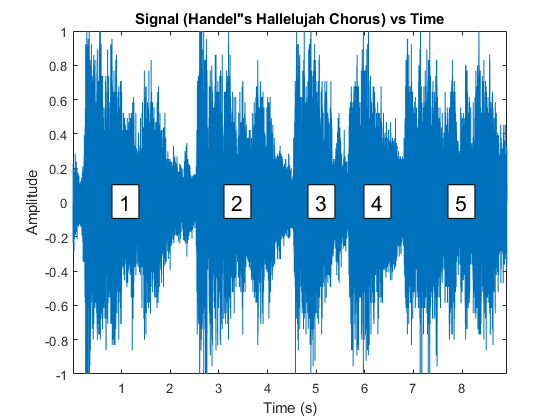Generate Audio Signals
This example shows how to generate audio signals using a 5.1 channel sound system.
Load Audio Signal
Load an audio file containing a sample of Handel's "Hallelujah Chorus."
load handel;
Plot Audio Signal
Plot the data to identify five distinct segments. Each segment represents a "Hallelujah" in the chorus. The segments are annotated as 1 to 5.
ly = length(y); lspan = 1:ly; t = lspan/Fs; hf = figure; plot(t,y./max(y)) axis tight; title("Signal (Handel''s Hallelujah Chorus) vs Time"); xlabel("Time (s)"); ylabel("Amplitude"); markers = struct('xpos',[0.2,0.4,0.55,0.65,0.8],'string',num2str([1:5]')); for i = 1:5, annotation(hf,'textbox',[markers.xpos(i) 0.48 0.048 0.080],'String', markers.string(i),'BackgroundColor','w','FontSize',16); end

Create a DataAcquisition and Add Audio Output Channels
This example uses a 5.1 channel sound system with device ID 'Audio2'.
1. Create a DataAcquisition with directsound as the vendor and add an audio output channel to it.
dd = daq("directsound"); nch = 6; addoutput(dd, "Audio2", 1:nch, "Audio");
2. Update the generation scan rate to match the audio sampling rate.
dd.Rate = Fs;
3. Generate audio signals (Handel's "Hallelujah Chorus"). "Hallelujah" should be voiced five times, one for each segment depicted in the figure on all channels of the speaker system.
write(dd, repmat(y,1,nch));
4. Close the figure.
close(hf);
